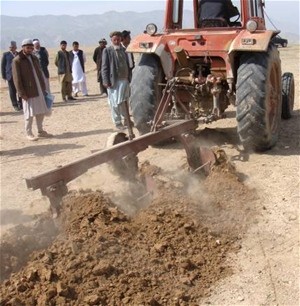
A tractor plows land in Balkh’s Dihdadi district to ensure that wild pistachio seedlings have proper spacing and irrigation.
USAID/ASAP
Pistachio reforestation brings jobs and improves the environment.
12 AUGUST 2009 | MAZARI SHARIF, AFGHANISTAN
USAID is helping rural Afghans improve their environment and their incomes by planting pistachio seedlings. Wild pistachio forests were once common in northern Afghanistan, but years of improper harvesting and neglect led to the destruction of many forests. Now, a USAID cash-for-work project is underway that will restore pistachio forests covering 700 hectares in Balkh Province while providing jobs for local residents.
More than 2,100 Afghans are participating in the planting of almost 300,000 pistachio seedlings, covering two districts in Balkh. “I see two very important advantages of this project,” said Qader, one of the laborers at the pistachio planting site in Dihdadi district. “It will fight pollution and protect the environment, and it will create jobs and a source of income in the long term.”
To ensure proper irrigation and to limit erosion, tractors plow rows for the pistachio seedlings and the workers then shape each row with shovels. Water pumps and a network of pipes will transport irrigation water from the Balkh river to man-made reservoirs at the planting sites.
The forests will provide nuts and income for years to come. The wild pistachios are a hardy variety that will reach maturity in 7 to 10 years. Fully grown pistachio trees will yield about 10 kg of pistachios each, which will sell for $3 per kg in local markets. “The pistachio forestation project is really an innovation in this area,” Qader said. “It encourages other farmers to promote this important product, which will in turn help to improve our economy.”
USAID worked with Afghanistan’s Ministry of Agriculture, Irrigation and Livestock (MAIL) and Community Development Councils to identify planting sites in the province. After maintaining and monitoring the seedlings for seven months to ensure they are well established, USAID will hand over the project to the MAIL. The MAIL will continue to provide support to the local areas, demonstrating that both international organizations and the Afghan Government are working to improve the lives of Afghan citizens.







Comment
Make a general inquiry or suggest an improvement.